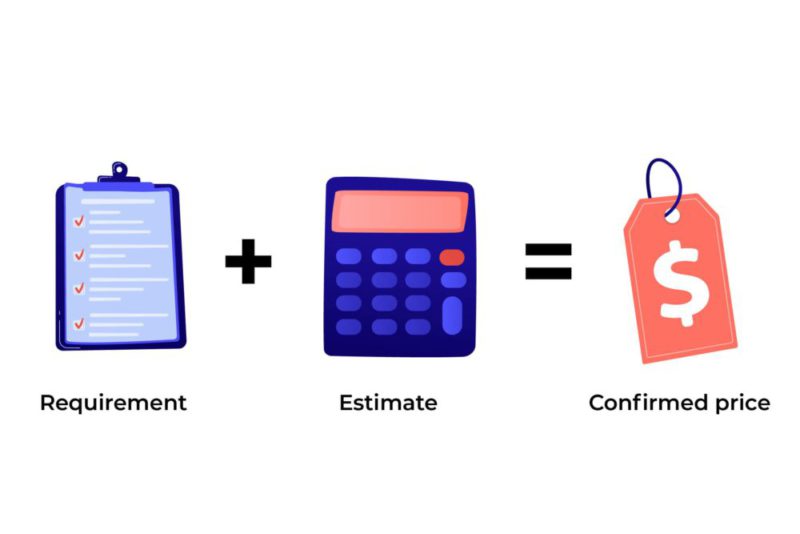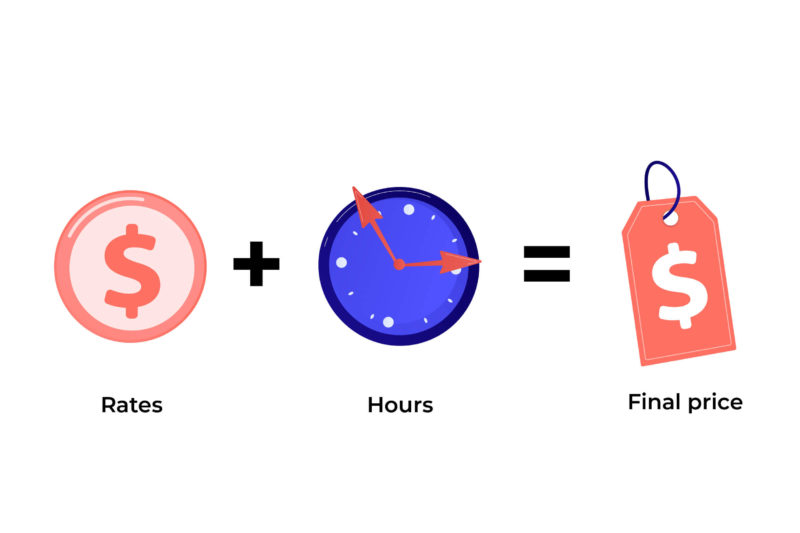In the dynamic landscape of IT outsourcing, choosing the right model between many types of IT outsourcing pricing models can be a critical decision for businesses. This blog aims to demystify the realm of IT outsourcing pricing models, helping businesses make informed decisions based on their unique project requirements, budget constraints, and risk tolerance. By understanding the strengths and potential drawbacks of these types of IT outsourcing pricing models, you can embark on your outsourcing journey with confidence.
1. Fixed-price
1.1. Introduction

The fixed-price model is one of the IT outsourcing pricing models that involves the outsourcing company providing a set price for the entire project. Under this model, the outsourcing company complements the project within the agreed-upon budget and timeline, and the client knows exactly how much they will pay for the project from the outset. This may include a certain number of support hours, server or shortage devices, or a certain amount of data transfer. The price of the services is typically based on the volume of services provided rather than the actual resources used.
1.2. Advantages of the Fixed-Price Model
- Predictable project costs: With costs set in stone from the outset, clients can accurately forecast and allocate resources, sparing them from the uncertainties that often accompany other pricing models.
- Clear project scope: By meticulously defining deliverables and requirements in advance, both the client and the service provider are aligned on project expectations, paving the way for a seamless collaboration.
- Reduced financial risk: Many businesses enjoy the sense of financial security that comes with a fixed-price agreement, they can process their projects with confidence and peace of mind, which allows them to better plan their budgets.
1.3. Limitations of the Fixed-Price Model
- Limited flexibility: Since the scope and costs are firmly established at the outset, any deviation from the initial plan can be cumbersome to implement. It may also be less cost-effective for companies with fluctuating IT needs, as they may pay for services they do not use.
- Risk of overpricing: Uncertainties and unexpected challenges can arise, leading to additional work or alterations in scope that weren’t accounted for in the original agreement.
- Challenges in adapting to evolving project requirements: The Fixed-Price Model may struggle to keep pace with shifting needs. This can lead to inefficiencies, delays, or even dissatisfaction if the project’s original scope no longer aligns with the client’s evolving objectives.
2. Time and Material (T&M)
2.1. Introduction

Compared to other types of IT outsourcing pricing models, time and material is a flexibility model where the outsourcing company charges the client for the actual time and materials used to complete the project. With this model, the client can adjust the project scope and requirements as necessary throughout the development process, and the outsourcing company typically provides a team of professionals who work on an hourly or daily basis.
2.2. Advantages of the Time and Material Model
- Accommodates evolving changes: It allows businesses to seamlessly incorporate modifications, additions, or shifts in project focus without the need for complex contract renegotiations.
- Allows for a dynamic and adaptable approach: This model enables a more iterative and responsive workflow. It’s particularly well-suited for projects with a degree of uncertainty or those that involve research and development, where the exact trajectory may not be entirely clear from the outset.
- Transparent cost breakdown: Clients receive a clear and detailed account of the resources utilized, including hours worked and materials used. The price is easier to manage, there are no strict deadlines or time limits, and both parties can pay more attention to details
2.3. Limitations of the Time and Material Model
- Potential for cost overruns: Since the billing is based on actual hours worked and materials used, without careful oversight, costs can escalate beyond the initial estimates.
- Requires active project management and oversight: This is because the model’s success hinges on continuous monitoring of resource utilization, progress tracking, and regular communication between the client and the service provider.
- The client may face uncertainty regarding final project costs: Unlike fixed-price models, where costs are established upfront, this model’s pricing structure is contingent on the actual work performed. While the transparency in cost breakdown is an advantage, it may require clients to have a more flexible budgetary approach to accommodate potential fluctuations in costs.
3. Dedicated Team
3.1. Introduction
In IT outsourcing pricing models with this structure, the IT outsourcing company assembles a team with the necessary skills and experience to work exclusively on the client’s project, and the client will pay them a fixed monthly fee. With this model, the client will have full control and flexibility over the team composition. The dedicated team becomes fully integrated into the client’s project development team throughout the project’s duration.
3.2. Advantages of the Dedicated Team Model
- Full control over team members: This control extends not only to selecting the members but also to managing and directing their efforts, fostering a sense of ownership within the team. Team members become deeply invested in the project’s success, resulting in heightened dedication, accountability, and a genuine commitment to achieving the client’s objectives.
- Scalability, allowing for adjustment of resources: It allows for seamless adjustment of resources based on evolving project requirements. As project demands change, the team’s size and composition can be adapted accordingly.
- Long-term collaboration: Through ongoing, extended partnerships, team members gain a deep understanding of the client’s business, industry, and unique challenges. This not only leads to more effective problem-solving but also allows the team to provide proactive suggestions and recommendations.
3.3. Limitations of the Dedicated Team Model
- May not be cost-effective for short-term or one-time projects: This model is optimized for long-term, ongoing collaborations where the benefits of dedicated resources and deep domain expertise can be fully leveraged. For projects with a defined scope and limited duration, the overhead costs associated with maintaining a dedicated team may outweigh the benefits.
- Requires active management and coordination by the client: While having full control over the team members provides a sense of ownership, it also implies a greater responsibility for oversight. The client must actively engage in managing the team, including tasks such as task prioritization, progress tracking, and addressing any potential roadblocks.
- Potential for dependency on dedicated team members: As team members become intimately familiar with the client’s projects and processes, there’s a risk that their absence, whether due to turnover or unforeseen circumstances, could lead to disruptions.
4. Value-based
4.1. Introduction
Value-based model is slightly different from other types of IT outsourcing pricing models, rather than the time or effort spent on the project, the outsourcing company charges based on the value that the project or service brings to the client’s company. The pricing is based on the expected return on investment (ROI) or other key performance indicators (KPIs). Businesses using the value-based pricing model are better positioned to adjust their pricing strategies in response to shifting market dynamics.
4.2. Advantages of the Value-based Model
- Maximizing profits: This approach recognizes that customers are often willing to pay more for a product or service that provides substantial benefits or solves specific pain points. By aligning the price with the perceived value, businesses can optimize their revenue streams. This not only increases profitability but also ensures that the client feels they are receiving fair value for their investment.
- Building strong customer satisfaction: When clients feel that they are receiving substantial benefits and unique advantages, they are more likely to be satisfied with the service provided. This satisfaction, in turn, leads to greater client retention, positive word-of-mouth referrals, and a strengthened brand reputation.
- Adapting to market changes and customer preferences effectively: The perceived value of a product or service can fluctuate based on market conditions, technological advancements, and evolving customer expectations. As such, businesses using the value-based Model are better positioned to adjust their pricing strategies in response to shifting market dynamics.
4.3. Limitations of the Value-based Model
- Requires in-depth market research and customer understanding: This often requires extensive market research, customer interviews, and data analysis to accurately gauge what customers are willing to pay. For businesses that lack the resources or time for thorough research, this can be a significant challenge.
- Complexity in setting price: Your whole target market might have to vary perceived values for your products and services, making it harder to set a price point that works for every customer.
Not suitable for easily comparable products or industries: The Value-Based Pricing Model may not be the best fit for industries or products where alternatives are easily comparable based on standard criteria such as specifications, features, or pricing. In such cases, customers may not perceive significantly different values between options, making it difficult to justify premium pricing.
5. Comparison Between Four Types of IT Outsourcing Pricing Models
The table below will briefly show the differences between four types of IT outsourcing pricing models: fixed-price, time & material, dedicated team, and value-based.
Fixed-price | Time & Material | Dedicated Team | Value-based | |
| Advantages | – Clear scope definition and well-defined project deliverables. – Minimal financial risk for the client. – A predictable, fixed budget for the entire project. | – Flexibility for changes and updates during the project. – Allows for a dynamic and adaptable approach. – Transparent cost breakdown. | – Full control and flexibility over the team composition. – Scalability according to project needs. – Long-term collaboration and knowledge retention. | – Maximizing profits. – Building strong customer satisfaction. – Adapting to market changes and customer preferences effectively. |
| Limitations | – Challenges in adapting to evolving project requirements – Uncertainties and unexpected challenges can arise – Any deviation from the initial plan can be cumbersome to implement | – Costs can escalate beyond the initial estimates. – Requires active project management and oversight. – Client may face uncertainty regarding final project costs. | – May not be cost-effective for short-term or one-time projects. – Requires active management and coordination by the client. – Potential for dependency on dedicated team members | – Requires In-Depth Market Research and Customer Understanding. – Complexity in Setting Price – Not Suitable for Easily Comparable Products or Industries. |
Which Types of IT Outsourcing Pricing Models are Suitable for Your Business?
The best model among these types of IT outsourcing pricing models for your business will depend on the specific characteristics of your project, your business objectives, and your comfort level with the control and flexibility offered by each model. For more information about these types of IT outsourcing pricing models, you can read our Ebook about IT Outsourcing:
Read more: [EBOOK] Strategic IT Outsourcing: Optimizing Cost and Workforce Efficiency
Or you can contact VTI, we would be happy to assist you.
VTI – Innovation Technology Value
Hotline: (+84) 24 7306 9996
Email: [email protected]
Location: Vietnam, Japan, Korea, Singapore
Facebook: https://www.facebook.com/VTI.JSC/
LinkedIn: https://www.linkedin.com/company/vtijsc/
![[FREE EBOOK] Strategic Vietnam IT Outsourcing: Optimizing Cost and Workforce Efficiency](https://vti.com.vn/wp-content/uploads/2023/08/cover-mockup_ebook-it-outsourcing-20230331111004-ynxdn-1.png)




